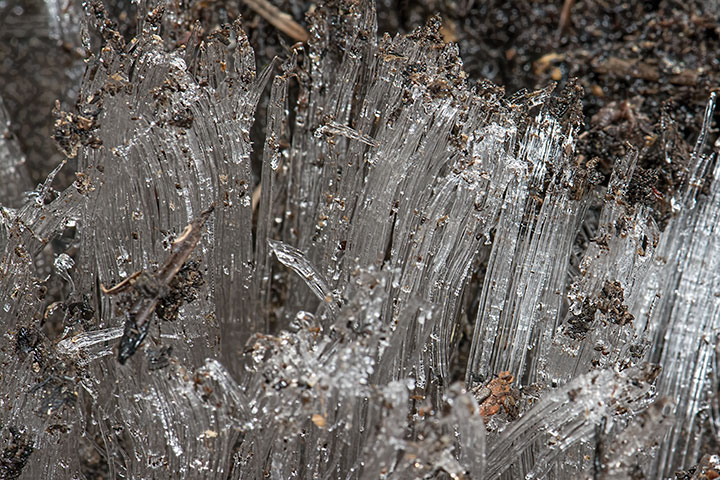Myriad small columns of ice rise out of the ground. These are ice extrusions.
Typically, these are seen when the daytime temperature is above 0C and the nighttime temperature is below. During daytime, water drains into the cavities within a porous soil; during nighttime, the freezing water expands forcing little columns of ice up through the ground. Those of us who remember the home delivery of milk to a cold doorstep in the winter are already familiar with the process whereby the cap of the milk bottle was lifted atop a column of frozen cream.
Sometimes an extrusion is long enough to bend and droop like a petal under its own weight. This sinuous form prompts some to call them ice flowers, but they, despite that descriptor, should not be confused with frost flowers.
Although an ice extrusion and a frost flower both appear as small frozen structures above the ground surface, each is distinctly different in origin. The ice extrusion arises from the freezing of what was initially liquid water in the ground; the frost flower arises from the condensation of what was initially water vapour above the ground.
Myriad ice extrusions arise from the ground.

Hi Alistair,
It is usually called needle ice or piprake (swedish) and is quite effective in loosening soil and small rocks so that it aids in material creeping slowly down slope. I have seen needle ice up to 7.5 cms in length where there has been only slight melting during the day and 3 or more consecutive nights of frost.
Lesley.
PS I am really sorry that I missed your presentation at WKNA, but I did not find out about it until later in the week. You always have superb photos.
Lesley, thank you for that insight into terminology. Knowing that geologists refer to the structures as needle ice has opened up a new range of literature for me. Unfortunately, meteorologists use the terms needle ice and ice needle for two very different structures, so we seem to lack a common terminology. I see now that Wikipedia has an article about (the geologist’s) needle ice. But, then it links to one about frost flowers, which, unlike the frost flowers I discuss, are not actually a form of frost, but rather an ice extrusion. However, discovering the insights of other disciplines is part of the fun of creating this blog where the pictures provide the common language.
And thank you for your remarks about my recent presentation to the West Kootenay Naturalists. I will be giving it again in Castlegar on May 18th to the West Kootenay Camara Club (and to two other groups between now and then).
Thanks Alistair
Exactly what I was inquiring about
Charlie